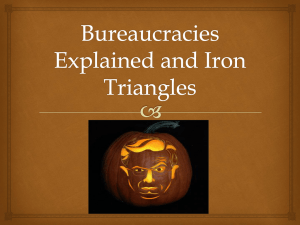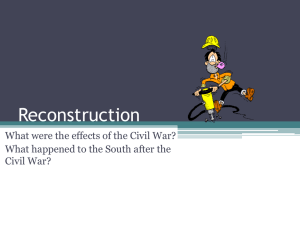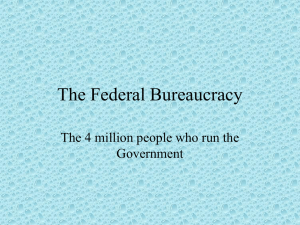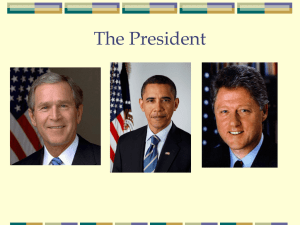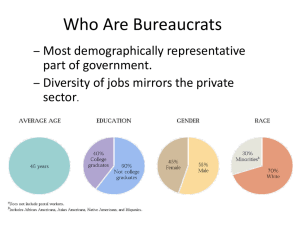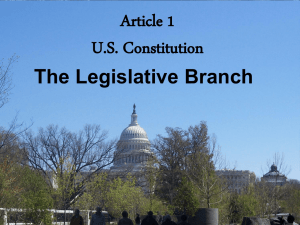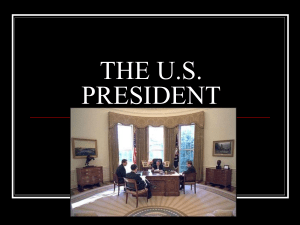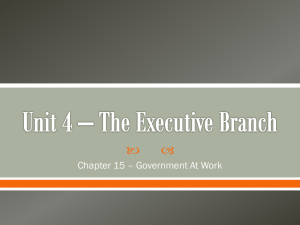File - Denison Middle Civics
advertisement
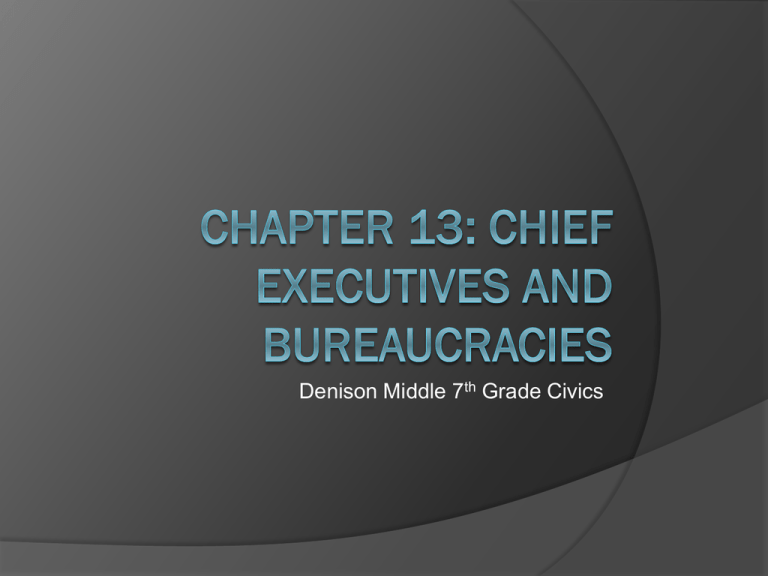
Denison Middle 7th Grade Civics 13.2: Chief Executives, Mayors, Governors, and Presidents The president is the national government’s chief executive, the top elected official in charge of enforcing laws and carrying out government policy. Formal Qualifications: Age Citizenship, and Residency The President must be: a native-born citizen at least 35 years old lived in the country for at least 14 years The 22nd Amendment, added another rule: no one who has been elected president twice or has served one full term plus more than half of another term can seek the office (presidency) again. Most state and local governments set less stringent requirements for their chief executives. Informal Qualifications: Experience, Education, and Other Factors Like lawmakers, chief executives must also satisfy certain informal qualifications for office. Typically, chief executives have backgrounds in business, law, or public service. Most are well educated Nearly ¾ of all presidents have earned a college degree. Most have also worked their way up the political ladder by holding other elective offices. Informal Qualifications: Experience, Education, and Other Factors Historically, most chief executives have been white, male, and from the middle or upper class. In 2007, a record 9 of the 50 state governors were women. Only 2 African Americans -Douglas Wilder of Virginia and Deval Patrick of Massachusetts- have served as governor. Almost all U.S. presidents have been Protestant. Gaining Office: Election and Succession Most chief executives, including governors and mayors, are elected by popular vote. The president is chosen by the Electoral College, based on the popular vote count in each state. Gaining Office: Election and Succession In some state and local elections, the candidate who wins a plurality of the vote is declared the winner. In other states and cities, the candidate must receive a majority of the votes cast to win. If that does not happen, the top 2 candidates must compete in a runoff election, which is designed to produce a clear winner. Gaining Office: Election and Succession Succession rules for the presidency are spelled out in the Constitution and federal law. The line of succession for the presidency begins with the vice president. If the vice president cannot serve, the next successor is the Speaker of the House, followed by the president pro tempore of the Senate, and then by the secretary of state. Other members continue the line of succession in a specific order. In most states, a lieutenant governor holds a comparable position to that of the vice president. Staying in Office: Impeachment, Recalls, Term Limits, and Incumbency If a president, vice president, or other official in the executive branch is suspected of wrongdoing, that person may be impeached and removed from office. To be removed from office, an official must be convicted of “Treason, Bribery, or other high Crimes and Misdemeanors”. Impeachment begins in the House of Representatives. A majority of House members must vote to impeach, or formally accuse, the president or other officer of wrongdoing. The trial is then held in the Senate. 2/3 of the senators must find the official guilty to remove that person from office. ○ The House has impeached only 2 presidents- Andrew Johnson and Bill Clinton- and the Senate found neither guilty. Staying in Office: Impeachment, Recalls, Term Limits, and Incumbency What if citizens are unhappy with the job their chief executive is doing? For presidents, there is no provision for midterm removal based on job performance. Many states and cities have a procedure by which voters can order a recall of an elected official. Staying in Office: Impeachment, Recalls, Term Limits, and Incumbency Presidents are restricted to no more than two terms in office. In most cases, governors are held to two terms in office. In some states, they may run for reelection four years after their last term. The power of incumbency in winning reelection is not as strong for chief executives as it is for legislators. That may be because the chief executive serves as a “lightning rod” for voter discontent. 13.3: The Growth of Presidential Power The U.S. president today is viewed as the most powerful national leader in the world. In the 1800s presidents acted mainly as the “chief clerk”. Other than carrying out the will of Congress, they assumed little authority other than those powers explicitly listed by the Constitution. Powers Granted to the President Under the Constitution One of the most important powers is that of commander in chief of the armed forces. The president also has the power to grant reprieves and pardons. A reprieve is a postponement of punishment, whereas a pardon is a release form punishment. President’s may also grant amnesty, or a blanket pardon, to people facing prosecution. Powers Granted to the President Under the Constitution The president’s greatest formal power stems from Article II, Section III, of the U.S. Constitution. This section directs the president to “ take care that the Law be faithfully executed”. This “take care” Clause grants the president flexible powers to enforce the law and fulfill other executive duties. George Washington (1789-1797): Establishing Precedents As the nation’s first president, Washington knew that every action would help shape the office for future generations. Washington set many precedents such as: Being addressed as “Mr. President” instead of “your highness”. He also declined to seek reelection after serving two terms in office. George Washington (1789-1797): Establishing Precedents Washington set the model for how the executive branch should be run. He appointed the first department heads and brought them together to create the first cabinet. Washington took tough action when necessary to ensure that acts of Congress were “faithfully executed” to make sure that the president would be respected as a figure of authority. This was acted upon in the Whiskey Rebellion of 1791, where Washington led 13,000 militia troops into western Pennsylvania to enforce Congress’ tax on the sale of whiskey. Andrew Jackson (1829-1837): Champion of “The People” Jackson was elected president at a time when many states had eliminated property requirements for voting. As a result, he was the first occupant of the White House who could claim that he was elected by “the people”. Previous presidents vetoed acts of Congress only when they viewed them as unconstitutional. Jackson vetoed legislation simply because he disagreed with it or thought it ran counter to the people’s interests. Andrew Jackson (1829-1837): Champion of “The People” During his two terms in office, Jackson vetoed 12 bills, more than were struck down by all of his predecessors combined. Jackson’s most famous veto involved a bill renewing the charter of the National Bank of the United States. Abraham Lincoln (1861-1865): Savior of the Union By the time Lincoln took office, 7 southern states had seceded from the United States. Lincoln declared martial law in Maryland and other states, placing the people under military rule. He shut down newspapers that advocated secession and suspended habeas corpus so that people suspected of treason could be arrested and jailed by the military without worrying about due process. Abraham Lincoln (1861-1865): Savior of the Union All these actions were taken without congressional approval. A federal court ruled in Ex parte Merryman (1861) that suspension of habeas corpus was unconstitutional, Lincoln ignored the ruling. On January 1, 1863, Lincoln released the Emancipation Proclamation as an executive order, a rule issued by the president that has the force of law. With the order, Lincoln transformed the war for the union into an antislavery crusade. Theodore Roosevelt (1901-1909): The “Bully Pulpit” Roosevelt used the presidency as a platform from which to speak out on important public issues. He created government agencies to ensure safer food and drugs. He promoted conservation of the nation’s resources by creating the National Park Service. He pursued an active foreign policy in the belief that the United States was destined to be a great power. Franklin D. Roosevelt (1933-1945): Maker of the Modern Presidency Like Lincoln, FDR came into office during a time of crisis: the Great Depression. During his first 100 days in office, Roosevelt called Congress into special session and presented it with 15 major bills. Roosevelt won passage of such groundbreaking programs as Social Security and unemployment insurance. FDR addressed the American people directly, in their own homes through a series of radio broadcasts known as “fireside chats”. 13.4: The Modern President’s Job The Many Roles of the President Chief executive: As the country’s chief executive, the president acts much like the head of a large corporation. In this role, the president presides over the federal bureaucracy, or the various agencies and organizations that carry on the daily business of the government. The president is responsible for appointing close to 2,000 federal officials who oversee the work of nearly 2 million civilian employees of the federal government. The Many Roles of the President Chief of state: The president also acts as chief of state, the ceremonial leader of the government . As chief of state, the president represents the United States at official functions, both at home and abroad. The Many Roles of the President Commander in chief: This role puts the president as the head of the armed forces. The framers believed that it was important for the nation’s top civilian leader to have control over the armed forces. There are also limits on the president’s control by giving Congress the power to declare war. In 1973, Congress passed the War Powers Act, which requires the president to get congressional approval to wage war. The Many Roles of the President Chief diplomat: In this role, the president oversees U.S. foreign policy, holds talks with foreign leaders, and negotiates treaties. The Constitution directs the president to seek the advice and consent of the Senate in making treaties. The Many Roles of the President Chief policymaker: Since FDR, the president has been served as chief policymaker. The president normally sets policy agenda for Congress in the annual State of the Union address. The Many Roles of the President Chief manager of the economy: The president does work with Congress to write a federal budget and set tax policy. The Many Roles of the President Chief of party: The president is the leader of his or her political party. Presidents typically work to ensure that their party does well in congressional elections, in hopes of gaining or strengthening a congressional majority. Chief citizen: The president tries to embody American ideals and to serve the nation by acting in its best interest. Presidential Checks on the Other Branches As chief executive, the president can check the power of the legislative branch by approving or vetoing legislation passed by Congress. Likewise, the president can influence the power of the judicial branch by nominating judges to the Supreme Court and other federal courts. Presidential Checks on the Other Branches The presidential veto is a powerful tool for influencing policy. The president is required to sign or veto a bill within 10 days of receiving it from Congress. However, if Congress adjourns during those 10 days, the president can do nothing and will simply let the bill die- this is known as a pocket veto. Presidential Checks on the Other Branches The president can also check the power of Congress by invoking executive privilege. Executive privilege allows the president to deny access to White House documents, even when Congress wants to see them, on the grounds that keeping such records confidential is vital to the operations of the executive branch. 13.5: The Organization of the Executive Branch The Organization of the Executive Branch As chief executive, the president oversees and is assisted by the vast bureaucracy that makes up and manages the executive branch. This branch consists of 4 main groups: 1. The White House staff 2. The Executive Office of the President 3. The executive departments 4. Independent agencies The White House staff The White House staff consists of about 400 people. It includes the president’s lawyer, press secretary, various speechwriters, and many assistants. The most powerful staff member is the chief of staff, who is considered the president’s most loyal aide. The Executive Office of the President The Executive Office of the President (EOP) was created in 1939 by Congress to provide support staff to the president. Today it has about 1,800 employees. Key agencies include: the Office of Management and Budget, the Council of Economic Advisers (CEA), and the National Security Council ( MSC). The president can also add new agencies to the Executive Office of the President to carry out specific goals of their administration. The Executive Departments The executive departments make up a third group of organizations in the executive branch. These departments carry out the work of government in broad areas of public policy, such as agriculture, commerce, and labor. Departments include federal agencies that target the more specific policy areas within the department’s general focus. E.g.: The Federal Bureau of Investigation (FBI) is an agency that exists within the Justice Department. Independent Agencies The executive branch also includes dozens of independent agencies that help implement federal policy. These groups are considered independent because they don’t not fall within the executive departments though they answer directly to the president. One of the largest independent agencies is the National Aeronautics and Space Administration (NASA). 13.6: Local, State, and Federal Bureaucracies Government at every level depends on a bureaucracy to carry out public policies. Who Are Civil Servants, and What Do They Do? Bureaucracies are run by civil servants, or civilian employees working in government agencies. The work done by civil servants ranges from nursing and photography to engineering and economic analysis. What Are the Sources of Bureaucratic Power? Power stems from various sources: Legislative and budgetary support- A bureaucracy relies on laws and adequate funding to support its work Interest groups support Expertise of bureaucrats Longevity or permanence- The longer a government agency exists, the more likely it is to enjoy substantial power Effective leadership Citizen demand- Concerned citizens can help expand and strengthen bureaucracy by demanding government action to solve a problem Ultimately, bureaucracies work under the direction of an elected or appointed chief executive, whether a mayor, a city manager, a governor, or the president. To help weed out corruption, Congress has also passed laws to protect whistle-blowers, or employees who expose wrongdoing. Is the Growth of Bureaucracy Out of Control? Bureaucracy has grown at all levels of government since the country was founded. Much of this growth has occurred since the end of WWII, particularly since the 1960s, as government has provided more services to the American people. The size of the federal workforce today is about the same as it was in 1960. The shrinking of the federal bureaucracy has been made possible through privatization, or the practice of contracting private companies to do jobs once done by civil servants. How Have Bureaucracies Affected Our Lives? The strongest argument in defense of government bureaucracy is its success in improving the lives of many Americans. A short list of achievements in the past few decades would include the following: Fewer people living in poverty Better air and water quality More rights for women and minorities Safer food and drugs Lower crime rates Safer highways Higher high school graduation
